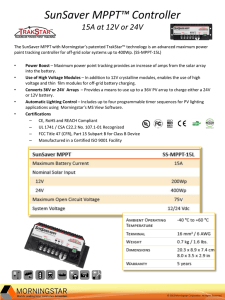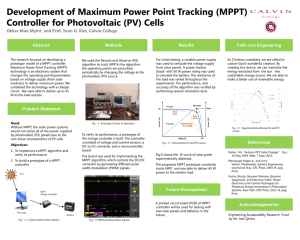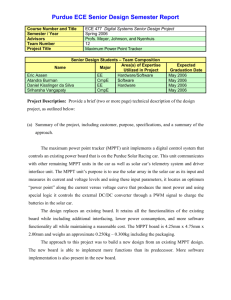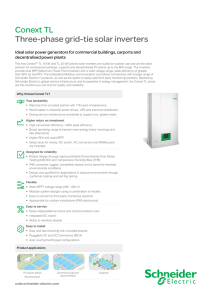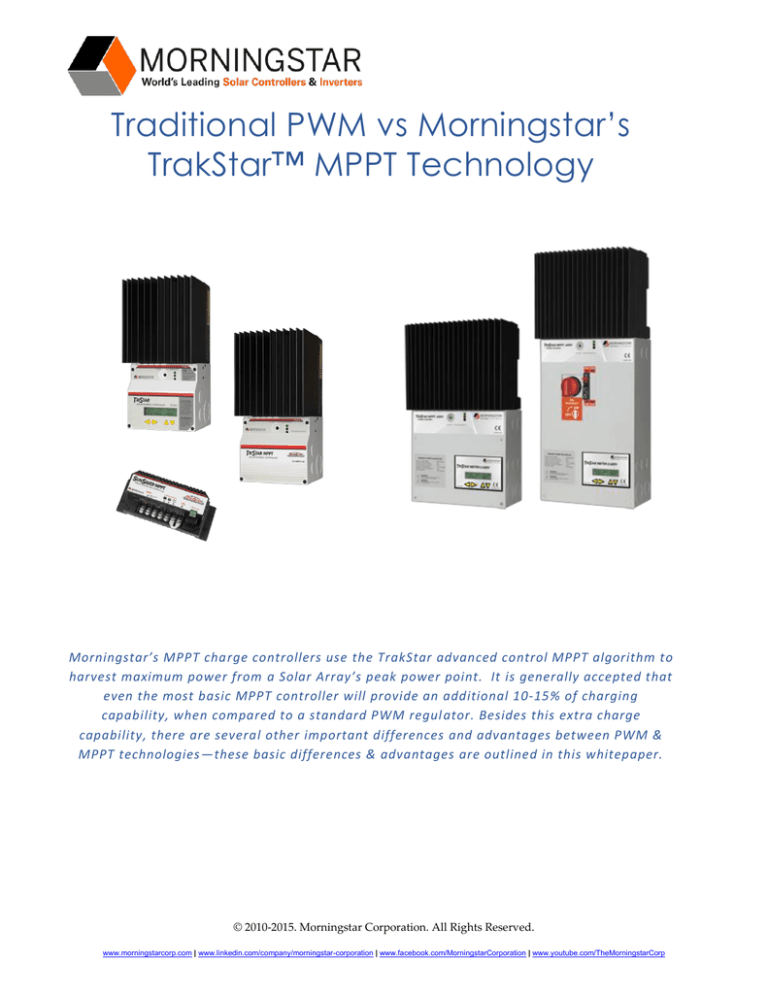
Traditional PWM vs Morningstar’s
TrakStar™ MPPT Technology
Morningstar’s MPPT charge controllers use the TrakStar advanced control MPPT algorithm to
harvest maximum power from a Solar Array’s peak power point. It is generally accepted that
even the most basic MPPT controller will provide an additional 10‐15% of charging
capability, when compared to a standard PWM regul ator. Besides this extra charge
capability, there are several other important differences and advantages between PWM &
MPPT technologies—these basic differences & advantages are outlined in this whitepaper.
© 2010-2015. Morningstar Corporation. All Rights Reserved.
www.morningstarcorp.com | www.linkedin.com/company/morningstar-corporation | www.facebook.com/MorningstarCorporation | www.youtube.com/TheMorningstarCorp
Traditional PWM vs Morningstar’s TrakStar™ MPPT Technology
Traditional PWM vs Morningstar’s TrakStar™ MPPT Technology
Introduction:
Morningstar MPPT (Maximum Power
Point Tracking) charge controllers’
utilize Morningstar’s advanced
TrakStar MPPT technology to harvest
the maximum amount of power from the solar array. It is generally
accepted that even the most basic MPPT controllers will provide an
additional 10‐15% of charging capability compared to a standard
PWM regulator. In addition this efficiency, there are several other
important differences and advantages between PWM & MPPT
technologies—these basic differences & advantages are outlined in
this whitepaper. This whitepaper will also provide an explanation
TrakStar MPPT
Morningstar’s
Advanced Control
Algorithm to
Harvest Maximum
Power from a Solar
Array’s Peak Power
Point
on how to properly size solar arrays for each type of controller.
Even the largest and
PWM Charging:
Traditional solar regulators featuring PWM (Pulse Width
Modulation) charging operate by making a connection directly
from the solar array to the battery bank. During bulk charging
when there is a continuous connection from the array to the battery
most efficient controller
can give up crucial
power if it is not
tracking the power
point of the module
correctly.
bank, the array output voltage is ‘pulled down’ to the battery
Speed and logic in the
voltage. The battery voltage adjusts slightly up depending on the
tracking algorithm will
amount of current provided by the array and the size and
yield gains that pure
characteristics of the battery.
size and efficiency
cannot make on their
own.
Page 1
The Morningstar Name and the Morningstar Logo, TriStar MPPT, SunSaver MPPT, TriStar, MeterHub and TrakStar are all the trademarks of Morningstar Corporation. MODBUS and
MODBUS TCP/IP are trademarks of Modbus IDA. © 2015 Morningstar Corporation. All rights reserved.
Traditional PWM vs Morningstar’s TrakStar™ MPPT Technology
The Vmp (maximum power voltage) is the voltage where the
product of the output current and output voltage (amps * volts) is
greatest and output power (watts = amps * volts) is maximized.
Module wattage ratings (e.g. 100W, 205W) are based on Pmp
(maximum power) at Vmp under standard test conditions (STC).
The greater the
difference between
battery voltage and the
Using a nominal 12V system as an example, the battery voltage will
Vmp of the array, the
normally be somewhere between 10 – 15 VDC. However, 12V
more energy is wasted
nominal solar modules commonly have a Vmp(STC) of about 17V.
by a PWM controller
When the array (having Vmp of 17V) is connected to the batteries
during bulk charging.
for charging, the batteries pull down the output voltage of the
array. Thus, the array is not operating at its most efficient voltage of
17V, but rather at somewhere between 10 and 15V. The following
graphs illustrate this phenomenon:
Because these traditional controllers rarely operate at the Vmp of the solar array, potential energy is
being wasted that could otherwise be used to better charge the battery bank and maintain power for
system loads. The greater the difference between battery voltage and the Vmp of the array, the more
energy is wasted by a PWM controller during bulk charging.
Page 2
The Morningstar Name and the Morningstar Logo, TriStar MPPT, SunSaver MPPT, TriStar, MeterHub and TrakStar are all the trademarks of Morningstar Corporation. MODBUS and
MODBUS TCP/IP are trademarks of Modbus IDA. © 2015 Morningstar Corporation. All rights reserved.
Traditional PWM vs Morningstar’s TrakStar™ MPPT Technology
TrakStar™ Maximum Power Point Tracking:
Morningstar MPPT controllers feature TrakStar technology, designed
to quickly and accurately determine the Vmp (maximum power
voltage) of the solar array. TrakStar MPPT controllers ‘sweep’ the
Staying on Track
solar input to determine the voltage at which the array is producing
the maximum amount of power. The controller harvests power from
»
Sweeps full array
the array at this Vmp voltage and converts it down to battery voltage,
from 0-150V in one
boosting charging current in the process.
tenth of a second!
Because power in is equal to the power out of the controller (assuming
»
take up to 30 seconds,
100% efficiency, neglecting wiring and conversion losses), it follows
during which power
that a down‐conversion of voltage corresponds to a proportional
levels could change.
increase in current. Power (watts) is equal to the product of voltage
and current, therefore, if voltage is reduced current must be increased
Some controllers can
»
Other controllers use
dynamic tracking,
to keep the input/output power equal.
adjusting locally,
Assuming 100% efficiency:
which can result in
missing the true Vmp.
Input Power = Output Power
Volts In * Amps In = Lower Volts Out * Higher Amps Out For example:
a 100W panel (Vmp of 17V) is used to charge a battery at 12V with a
Flexible Sweep Intervals
»
Morningstar’s MPPT
TrakStar MPPT controller. In ideal conditions, 5.88A of solar current
charge controllers
flow into the MPPT (100W / 17V = 5.88A). But the output voltage
sweep the array more
often when array
(battery voltage) is 12V, meaning current flow to the battery is 8.33A
voltages change.
(100W / 12V = 8.33A). You can see that the greater the voltage
difference between the Vmp
»
Enabling it to spend
and the battery, the more
more time on the
“boost” current the battery will
maximum power
receive. The graph on the left
point.
illustrates the advantage of
operating at the TrakStar MPPT.
A consequence of getting more “boost” when the voltage
difference is greater: the less charged the batteries are (lower
battery voltage), the more “boost” current they will receive. This
Page 3
The Morningstar Name and the Morningstar Logo, TriStar MPPT, SunSaver MPPT, TriStar, MeterHub and TrakStar are all the trademarks of Morningstar Corporation. MODBUS and
MODBUS TCP/IP are trademarks of Modbus IDA. © 2015 Morningstar Corporation. All rights reserved.
Traditional PWM vs Morningstar’s TrakStar™ MPPT Technology
is precisely the time when batteries will benefit from an increased amount of charging current.
Environmental Considerations:
Environmental conditions will cause the Vmp of a solar array to fluctuate with partial array shading
and module temperature having the most impact. MPPT technology allows the system to track the
changing Vmp and maximize energy harvest in any environmental conditions.
Another noticeable increase in charging efficiency, or taking advantage of the voltage differential
“boost” will be seen in colder temperatures. As solar modules drop in temperature, their Vmp
increases (see Appendix). Using a standard PWM regulator, a decrease in temperature would
correspond in almost no change in power. Since the array current stays the same the charging current
picks nothing up from the increased voltage. However, an MPPT controller tracks the increasing Vmp
and converts the excess voltage being produced into additional charging current. In general, any rise in
Vmp will increase an MPPT controller’s harvest relative to a PWM controller. (Conversely, any drop in
Vmp will decrease an MPPT controller’s harvest relative to a PWM controller).
As seasons change, the angle of the sun striking a solar module will change as well (assuming
stationary modules). The greater the angle of incidence, the less power a module will ultimately
produce. During times of the year where the angle of incidence is greatest (and relative power output is
decreased), MPPT technology is very useful for harvesting the maximum amount of energy.
MPPT controllers can play a big role in helping improve system performance, especially autonomy
considerations, for keeping the batteries charged during the winter months with less daylight hours
and sometimes poor incident angle. Again, the additional “boost” is the greatest when it may be
needed the most.
Array Sizing for PWM Regulators:
The first consideration in sizing the array for a PWM controller is open circuit voltage (Voc). Every
controller has a maximum input voltage rating. The array must have a temperature compensated (see
Appendix) Voc less than the controller’s maximum input voltage rating. During PWM switching
cycles, the controller input is exposed to the array open circuit voltage. Using an array with a
temperature compensated Voc greater than the controller input rating will damage the controller.
Next, consider the maximum power voltage (Vmp). The Vmp of the array needs to be higher than
the battery’s maximum charging voltage.
Page 4
The Morningstar Name and the Morningstar Logo, TriStar MPPT, SunSaver MPPT, TriStar, MeterHub and TrakStar are all the trademarks of Morningstar Corporation. MODBUS and
MODBUS TCP/IP are trademarks of Modbus IDA. © 2015 Morningstar Corporation. All rights reserved.
Traditional PWM vs Morningstar’s TrakStar™ MPPT Technology
Recommended values for Vmp are listed below:
12V systems: Vmp > 15V
24V systems: Vmp > 30V
36V systems: Vmp > 45V
48V systems: Vmp > 60V
A PV module’s output current will decrease significantly at voltages higher than Vmp and will be 0
Amps at Voc. Therefore, the temperature compensated Vmp of the array should be higher than full
battery voltage to ensure effective charging over the entire battery voltage range.
NOTE: The Vmp of the array should be higher than, but as close to, the maximum battery voltage as possible. Vmp
significantly higher than max battery voltage reduces efficiency and puts more stress on the switching components of the
regulator. Typically, for proper performance, 36 Cell or 72 Cell off‐grid modules (Vmp ≈ 17 to 18 V for every 12V nominal
battery voltage) should be used with PWM controllers.
Finally, the current output of the array is considered. Unlike MPPT controllers, standard PWM
controllers are not able to “boost” the amount of charging current by converting excess input voltage
into amperage. This means that the input current from the solar array will be equal to the output
current delivered to the battery. The solar array must be sized so that the short circuit current (Isc) does
not exceed the nameplate current rating of the controller being used. An array with Isc greater than the
current rating of the regulator may consistently trip overcurrent protections or damage the unit.
IMPORTANT: Local code may require additional reductions in maximum input Isc levels.
NOTE: Morningstar offers a String Sizer tool to assist in the proper sizing/configuration of your solar array with
Morningstar controllers. Users may choose between a selection of pre‐populated module data or input their own module
specifications. This tool also allows adjustment of design parameters such as range of expected battery voltages and min/max
temperatures at the site. A link to the String Calculator can be found on the Morningstar homepage:
www.morningstarcorp.com.
Page 5
The Morningstar Name and the Morningstar Logo, TriStar MPPT, SunSaver MPPT, TriStar, MeterHub and TrakStar are all the trademarks of Morningstar Corporation. MODBUS and
MODBUS TCP/IP are trademarks of Modbus IDA. © 2015 Morningstar Corporation. All rights reserved.
Traditional PWM vs Morningstar’s TrakStar™ MPPT Technology
Array Sizing for MPPT Regulators:
As with PWM regulators, the most basic concern when sizing an MPPT solar array is open circuit
voltage (Voc). The temperature compensated (see Appendix) Voc of the array must be less than the
maximum input voltage rating of the MPPT controller. Higher Voc has the potential to damage the
unit.
For a given MPPT current rating and nominal system voltage, there is an effective maximum
solar array wattage that can be used. Morningstar MPPT controllers have current ratings which specify
the maximum battery charge current the unit can support. NOTE: The battery charge current will be
lower than the solar input current due to the MPPT’s ability to “boost” charging amperage. The MPPT
output current rating multiplied by the battery voltage is the maximum amount of power which can be
used for charging the batteries. Any amount of power in excess of this could be lost when the controller
limits the charging current to the maximum output current level:
Example #1:
o A 15A MPPT controller is being used in a 12V nominal system (actual battery voltage
between 10V and 15V).
o Multiplying current rating and battery voltage gives about 200W (15A * 13.3V = 200W).
o The recommended maximum array wattage for this system is therefore 200W.
Example #2:
A 15A MPPT controller is now being used in a 24V nominal system (actual battery voltage
between 20V and 30V).
The recommended maximum array wattage will therefore be 400W (15A * 26.6V = 400W).
It is important to note that exceeding the maximum array wattage for a given
controller/nominal voltage combination will not damage the controller.
It is important to note that exceeding the maximum array wattage for a given controller/nominal
voltage combination will not damage the controller. Any wattage in excess of the max array
wattage will simply be lost. (i.e. Using a 300W array in a system where the max array W is only 200W
will not damage the controller, but the 300W array will have an operating power of approximately
200W maximum).
Page 6
The Morningstar Name and the Morningstar Logo, TriStar MPPT, SunSaver MPPT, TriStar, MeterHub and TrakStar are all the trademarks of Morningstar Corporation. MODBUS and
MODBUS TCP/IP are trademarks of Modbus IDA. © 2015 Morningstar Corporation. All rights reserved.
Traditional PWM vs Morningstar’s TrakStar™ MPPT Technology
IMPORTANT: MPPT controllers can be used with off‐grid or grid-tied modules. PWM controllers
should only be used with off‐grid modules.
Maximizing Efficiency:
Morningstar TrakStar™ MPPT controllers will operate at slightly different efficiencies depending
upon the nominal battery voltage being used, the Vmp of the array, and the total wattage of the
array. These efficiency curves are printed in the appropriate manual for every Morningstar MPPT
controller. This data can be used to optimally size your solar array for best performance and
maximum energy harvest.
NOTE: Morningstar offers a String Sizer tool to assist in the proper sizing/configuration of your solar array with
Morningstar controllers. Users may choose between a selection of pre‐populated module data or input their own module
specifications. This tool also allows for the adjustment of design parameters such as range of expected battery voltages
and min/max temperatures expected at the installation site. A link to the String Calculator can be found on the
Morningstar homepage: www.morningstarcorp.com.
Page 7
The Morningstar Name and the Morningstar Logo, TriStar MPPT, SunSaver MPPT, TriStar, MeterHub and TrakStar are all the trademarks of Morningstar Corporation. MODBUS and
MODBUS TCP/IP are trademarks of Modbus IDA. © 2015 Morningstar Corporation. All rights reserved.
Traditional PWM vs Morningstar’s TrakStar™ MPPT Technology
Maximizing MPPT Boost with a Morningstar MPPT Controller:
Morningstar’s TrakStar MPPT technology sets itself apart from other less effective MPPT solar
controllers on the market. Because of the following advantages Morningstar maintains consistently
better output power which translates into more MPPT Boost:
Consistently higher efficiencies under all operating conditions
Lower self-consumption power losses
No fans (lower efficiency power losses get turned into heat so fans are needed to use up
additional charging power)
Staying on Track. (Operates at MPPT levels more of the time)
This additional energy translates into a more consistently larger MPPT Boost. Given an MPPT
boost of 10%, just 1% higher efficiency would mean 10% more MPPT boost.
PWM Over MPPT:
The preceding discussion of PWM vs. MPPT may cause some to wonder why a PWM controller would
ever be chosen in favor of an MPPT controller. There are indeed instances where a PWM controller can
be a better choice than MPPT and there are factors which will reduce or negate the advantages the
MPPT may provide. The most obvious consideration is cost. MPPT controllers tend to cost more than
their PWM counterparts. When deciding on a controller, the extra cost of MPPT should be analyzed
with respect to the following factors:
1. Low power (specifically low current) charging applications may have equal or better energy harvest
with a PWM controller. PWM controllers will operate at a relatively constant harvesting efficiency
regardless of the size of the system (all things being equal, efficiency will be the same whether using
a 30W array or a 300W array). MPPT regulators commonly have noticeably reduced harvesting
efficiencies (relative to their peak efficiency) when used in low power applications. Efficiency
curves for every Morningstar MPPT controller are printed in their corresponding manuals and
should be reviewed when making a regulator decision. (Manuals are available for download on the
Morningstar website).
2. As explained in the Environmental Considerations section, the greatest benefit of an MPPT regulator
will be observed in colder climates (Vmp is higher). Conversely, in hotter climates Vmp is reduced.
A decrease in Vmp will reduce MPPT harvest relative to PWM. Average ambient temperature at the
installation site may be high enough to negate any charging advantages the MPPT has over the
Page 8
The Morningstar Name and the Morningstar Logo, TriStar MPPT, SunSaver MPPT, TriStar, MeterHub and TrakStar are all the trademarks of Morningstar Corporation. MODBUS and
MODBUS TCP/IP are trademarks of Modbus IDA. © 2015 Morningstar Corporation. All rights reserved.
Traditional PWM vs Morningstar’s TrakStar™ MPPT Technology
PWM. It would not be economical to use MPPT in such a situation. Average temperature at the site
should be a factor considered when making a regulator choice (See Appendix).
3. Systems in which array power output is significantly larger than the power draw of the system loads
would indicate that the batteries will spend most of their time at full or near full charge. Such a
system may not benefit from the increased harvesting capability of an MPPT regulator. When the
system batteries are full, excess solar energy goes unused. The harvesting advantage of MPPT may
be unnecessary in this situation especially if autonomy is not a factor.
PWM Charge Control
Technology Comparison
MPPT Charge Control
PV array & battery voltages must match
PV array voltage can be much higher
than battery voltage
Operates at battery voltage so it
performs well in warm temperatures and
when the battery is almost full
Operates above battery voltage so it is
can provide “boost” in cold
temperatures and when the battery is
low.
Typically recommended for use in
smaller systems where “boost” benefits
are minimal.
170W or higher to take advantage of
“boost” benefits more
Must use off-grid PV modules typically
with Vmp ≈ 17 to 18 Volts for every 12V
nominal battery voltage
Enables the use of lower cost/grid-tie
PV Modules helping bring down the
overall PV system cost
PV array sized in Amps (based on current
produced when PV array is operating at
battery voltage)
PV array sized in Watts (based on the
Controller Max. Charging Current x
Battery Voltage)
Simpler series switching charge control
circuit
Additional Energy Harvest by operating
at PV peak power point rather than
battery voltage
Page 9
The Morningstar Name and the Morningstar Logo, TriStar MPPT, SunSaver MPPT, TriStar, MeterHub and TrakStar are all the trademarks of Morningstar Corporation. MODBUS and
MODBUS TCP/IP are trademarks of Modbus IDA. © 2015 Morningstar Corporation. All rights reserved.
Traditional PWM vs Morningstar’s TrakStar™ MPPT Technology
Morningstar’s MPPT Controllers:
Morningstar presently offers five MPPT controllers: SunSaver MPPT™ for small PV systems and four
TriStar MPPT™ controllers for larger PV systems, as summarized below:
Morningstar MPPT Controllers Specifications Summary
Morningstar
Controller
SunSaver
MPPT
TriStar MPPT
(30 Amp, 45 Amp, 60 Amp versions)
15 Amps
30 Amps
45 Amps
60 Amps
60 Amps
200 Watts
400 Watts
600 Watts
800 Watts
NA
400 Watts
800 Watts
1200 Watts
1600 Watts
1600 Watts
NA
1600 Watts
2400 Watts
3200 Watts
3200 Watts
Maximum PV Open
Circuit Voltage
75 Volts
150 Volts
150 Volts
150 Volts
600 Volts
Communication
Ports for MeterBus
Yes
Yes
Yes
Yes
Yes
Communication
Ports for RS-232
No
Yes
Yes
Yes
Yes
Communication
Ports for EIA-485
No
No
No
Yes
Yes
Communication
Ports for Ethernet
No
No
No
Yes
Yes
Maximum Battery
Current
Nominal Maximum
Operating Power
for 12 Vdc batteries
Nominal Maximum
Operating Power
for 24 Vdc batteries
Nominal Maximum
Operating Power
for 48 Vdc batteries
TriStar MPPT-600V
(with & without DB)
Page 10
The Morningstar Name and the Morningstar Logo, TriStar MPPT, SunSaver MPPT, TriStar, MeterHub and TrakStar are all the trademarks of Morningstar Corporation. MODBUS and
MODBUS TCP/IP are trademarks of Modbus IDA. © 2015 Morningstar Corporation. All rights reserved.
Traditional PWM vs Morningstar’s TrakStar™ MPPT Technology
Wrap-Up:
The Solar Charge Controller is the Heart of a Stand-alone PV System. So what should you consider to
choose the right solar charge controller? Here is a Charge Controller Checklist that may help:
PWM or MPPT
Environmental Conditions
Accurate Fixed or Adjustable Regulation Set Points
Protections:
Lightning & Voltage Transient
Environmental (Tropicalization)
Electronic
Electrical Isolation
Communication Protocols & Interfaces:
Open (or Proprietary)
Modbus TCP/IP, SNMP & SMTP
Ethernet, EIA-485 & EIA-232
Page 11
The Morningstar Name and the Morningstar Logo, TriStar MPPT, SunSaver MPPT, TriStar, MeterHub and TrakStar are all the trademarks of Morningstar Corporation. MODBUS and
MODBUS TCP/IP are trademarks of Modbus IDA. © 2015 Morningstar Corporation. All rights reserved.
Traditional PWM vs Morningstar’s TrakStar™ MPPT Technology
Self-Diagnostic Capabilities
Information – LEDs, Meters, Alarms, Data Acquisition & Communication Ports
Temperature Compensation
Low Voltage Disconnect (LVD)
Battery, PV & Load Status
Low Self Consumption
Overall Quality (Automated or Hand Production):
Operating Life (MTBF & FIT Rates)
ISO 900x
Certifications: CE, UL, Class 1 Division 2, FCC Class B Part 15, etc…
5 Year Warranty
Proven Track Record
Ease of Use:
Large Wire Terminals
Clear Product Labels
User Friendly Documentation
Commercial:
Delivery Time
Inventory Levels
Variety
Post-Sales Support
Technical Support
Page 12
The Morningstar Name and the Morningstar Logo, TriStar MPPT, SunSaver MPPT, TriStar, MeterHub and TrakStar are all the trademarks of Morningstar Corporation. MODBUS and
MODBUS TCP/IP are trademarks of Modbus IDA. © 2015 Morningstar Corporation. All rights reserved.
Traditional PWM vs Morningstar’s TrakStar™ MPPT Technology
Appendix - Temperature Compensation:
It is important to take into account temperature compensation and understand how it relates to
both the output voltage and output current of a solar module.
Solar modules have performance ratings under standard test conditions (STC); normally a cell
temperature of 25°C and 1000W/m2 irradiance. Actual operating conditions will, of course, vary from
STC. Manufacturers publish temperature coefficients which can be used to determine module output
current/voltage under expected conditions. The two most important are the Voc and Isc Temperature
Coefficients.
The Voc temp coefficient, specified in volts per °C (or °F), is a negative value. This indicates
that the open circuit voltage of the module has an inverse relationship with temperature (Voc decreases
with increasing temperature and increases with decreasing temperature). When determining if the Voc
of an array is appropriate for the controller’s maximum input voltage, it is essential to take into account
temperature effects. In warm weather, the Voc of a module may be low enough to use with a certain
controller. However, as seasons change and temperature drops, the Voc may rise past a voltage safe to
use with that controller.
Worst case temperature effects should always be used when sizing an array. For example: the
Voc of a module under STC (25°C) is 21V. The Voc temp coefficient is ‐0.05V/°C. If the record low
temperature for the area in which the module will be placed is ‐10°C, the worst case (highest) Voc will
be 22.75Voc:
‐10°C ‐ 25°C = ‐35°C
‐35°C * ‐0.05V/°C = 1.75V
21V(@STC) + 1.75V = 22.75V(@‐10°C)
The Isc temp coefficient, specified in amps per °C (or °F), is a positive value. This indicates
that the short circuit current will rise with increasing temperature and fall with decreasing
temperature. Normally, the Isc coefficient is small enough to be neglected.
Revised 3/13/2015
Page 13
The Morningstar Name and the Morningstar Logo, TriStar MPPT, SunSaver MPPT, TriStar, MeterHub and TrakStar are all the trademarks of Morningstar Corporation. MODBUS and
MODBUS TCP/IP are trademarks of Modbus IDA. © 2015 Morningstar Corporation. All rights reserved.

